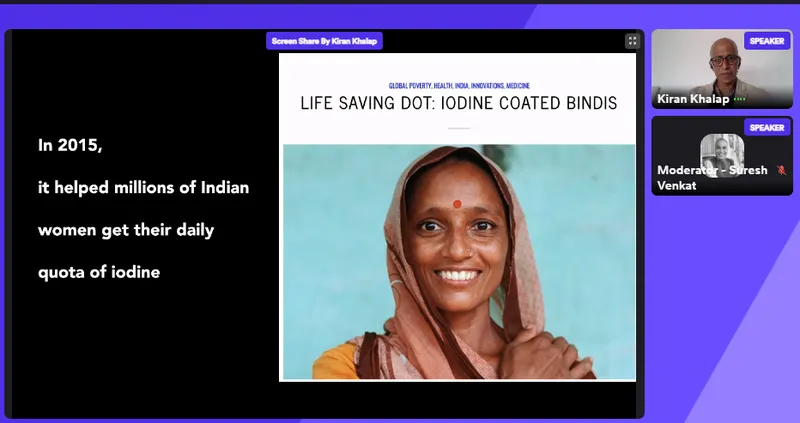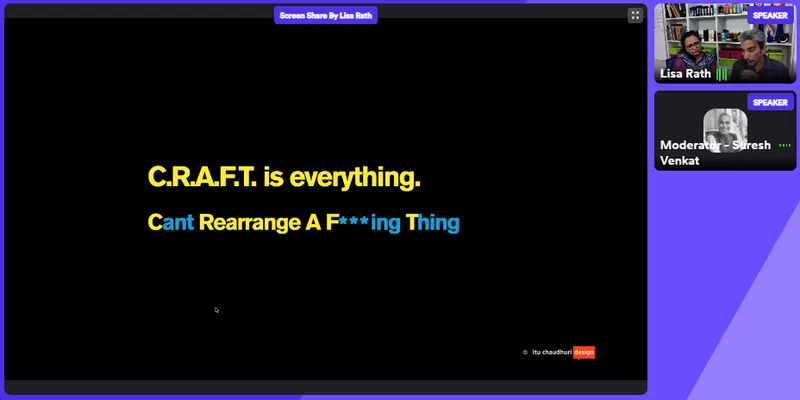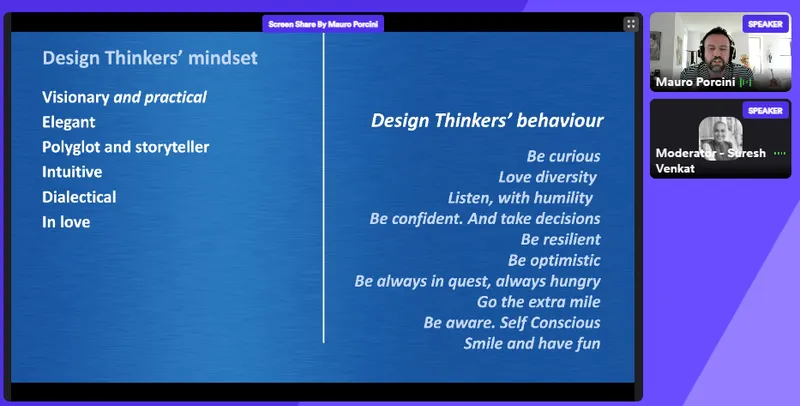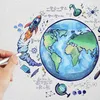From human-centred design to humanity-centred design: a call to action from Pune Design Festival 2021
The Pune Design Festival offers a wide variety of sessions in design, communication, and impact. Here are some takeaways on product, people, and purpose.
The 15th edition of the annual Pune Design Festival is being held online this week, due to the coronavirus pandemic. The seven-day event features 30 speakers as well as 10 workshops. See earlier write-ups on the 2021 and 2019 edition here, and the conferences and webinars (2017-2020). Our d.Zen (‘Design Zen’) section has more resources on design.
See also my reviews of the related books Design Your Thinking, How to Thrive in the Next Economy, Customer-driven Transformation, Customer Innovation, Creative Confidence, and Frugal Innovation. Check out our pick of Top Quotes of 2020 and 2019 on Design, and The ‘8 Is’ Framework for Design Thinking.

Mauro Porcini at PDF (1)
From products to people
Design is not just about attractive and functional products but also the emotional attachment of users and their overall experience, explained Mauro Porcini, who joined PepsiCo in 2012 as its first ever Chief Design Officer.
A culture of design thinking creates new approaches to developing product platforms and brands. Pepsi’s portfolio includes Gatorade, Tropicana, Lifewtr, Aquafina, Quaker, Naked, and many others.
Design spans packaging, events, advertising, fashion, art collaborations, and digital media, Mauro said. His design team is spread across over 10 countries, and has come up with a range of innovative offerings. This includes partnerships with artists for the Lifewtr bottles, smart kiosks for refilling beverages in bottles, and wearables to detect hydration and salt levels during athletic workouts.
Design-driven innovation meets the utilitarian, cognitive, and emotional needs of people. Products should be not just useful but pleasurable and meaningful, Mauro advised.
“The pandemic is a complex, difficult, and surreal moment,” he observed. “Everybody needs to innovate,” he added. This is particularly true in a global online environment where ideas and products can come from startups anywhere, and local events can become global events.
Design should be beautiful, meaningful, relevant, and add value, he advised. Design is about co-creation, and should involve customers in the creation of meaning. It is not just the product that is important, but people and the impact on those who they interact with.
Companies like Pepsico are often asked what they are doing to reduce their carbon footprint. The company is actively promoting recycling, and is changing the composition of plastic in its bottles, Mauro explained. However, customers should also do their bit, and media should promote responsible behaviours.

Kiran Khalap at PDF
Design and experiences
Design thinking helps product as well as service players. Design thinking perspectives helped Airnbnb improve the shared accommodation experience in its early days as a startup, explained Kiran Khalap, Co-founder, Chlorophyll Brand and Communications Consultancy. Stepping into customer shoes and taking high-quality photographs of the rental spaces improved user traction.
He also cited the Jeevan Bindi, an iodine patch that was designed like a regular bindi, as an example of design applied to address the problem of iodine deficiency among tribal women in Maharashtra in 2015.
Design and media
Design firm ICD’s founder Itu Chaudhuri and principal Lisa Rath shared effective examples of design combined with storytelling in journalism. Their clients include Malayala Manorama, Rajasthan Patrika, The Hindu, The Quint, Catch News, and Editorji.
“Allow creative solutions to come to you,” they advised. “We love our failures,” they added, supporting the iterative and experimental approach of design.
“Problem finding comes before problem solving,” they observed. Designers should look beyond the client’s brief, and immerse in the problems of the client’s clients and customers. “Your client’s clients are more important than your client,” they evocatively described.
Some problems, though, may be really challenging, such as those faced by India’s news media in the face of a government that is trying to control reportage. Editors are scared of the government and the market, Itu and Lisa lamented.

Itu Chaudhuri and Lisa Rath at PDF
Wicked problems: the pandemic and beyond
The pandemic has highlighted the urgent need for design to tackle the “big five” megatrends of environmental sustainability, safety, purpose, radical transparency, and equality, Kiran emphasised.
“Design thinking has a new possibility: the well-being of Earth and its inheritors. Human-centred design is now humanity-centred design,” he said.
Examples include Rolls-Royce making honey, Allbirds’ shoes with low carbon footprints, Johnnie Walker whisky to be sold in paper bottles, Patagonia’s embrace of transparency as a new business model, and Deloitte’s use of design thinking principles to address gender bias.
The COVID-19 pandemic has reduced socialisation, office time, and family get-togethers around the world, Kiran observed. However, some of the proposed design solutions have unintended impacts.
Increasing the number of shifts in offices to accommodate concerns around safe distancing will also increase electricity usage. Around 14 percent of all energy delivered in India is used in buildings, Kiran cautioned.
Distance learning will increase the digital divide, and poorer communities will be driven into child labour and even child marriage, he added.
Designing solutions that can anticipate unintended consequences requires bringing in a broader range of perspectives from different industries in the design process, Kiran suggested, in response to a question by this writer.

Mauro Porcini at PDF
Brand and purpose
Some audience members observed that many companies are parroting “purpose” as thinly-disguised PR in the pandemic era. “A brand is what a brand does,” Kiran explained, as proof of its true commitment to purpose.
Companies with a sense of purpose show commitment to the broader societies they serve and to the environment, and last longer as well. Kiran cited Japanese companies as examples of organisations that think beyond quarterly results; some of them have lasted 100-300 years.
Indian design should reflect the qualities of India itself. This includes India’s absorption, reflection, and expression of diverse influences, Kiran signed off, pointing to India’s cuisine and the rise of the ‘local’ as examples.
Edited by Teja Lele





![[YS Exclusive] Digital transformation is based on design thinking: Ranjit Tinaikar, Ness Global CEO](https://images.yourstory.com/cs/2/a9efa9c02dd911e9adc52d913c55075e/Imagewfan-1613303738734.jpg?fm=png&auto=format&h=100&w=100&crop=entropy&fit=crop)




